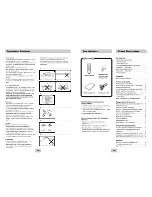
Chapter 12. Plugins
157
the same acceleration as in the first line. The last one is a part of 16 bars length that
changes tempo from 100 to 200 smoothly during its whole lifetime (6.25 bpm/bar). For
details on how the acceleration works, see
http://thomas.orgis.org/science/metronome-
It is also possible to provide a tempo for each individual beat in a part by separating
values with a comma (no spaces),
varibeat: 3 4/4 135,90,78,100,120,120,99,100,43,94,120,133
where the beat duration is first according to 135 bpm, then 90 bpm, and so forth. You
are required to provide a value for each beat in all bars of the part.
You can provide a pattern that controls how the beats are played:
Symbol
Meaning
X
emphasized beat (Tick)
x
normal beat (Tock)
.
silent beat
Some examples:
default: 0 4/4 120 Xxxx
rockon2: 0 4/4 120 xXxX
solea: 0 12/4 180 xxXxxXxXxXxX
shuffle: 0 12/12 120 x.xX.xx.xX..
funky: 0 16/16 120 x.x.X..X.Xx.X..X
The 12/12 for the shuffle create 1/4 triplets. Just do a bit of math;-) This is still a
metronome, not a drum machine, but it can act like a basic one, helping you to figure
out a certain rhythm within the meter.
The UI is developed so that it fits into the display of a Sansa Clip+ and that is the
hardware device it is tested on. It seems to work reasonably on some other models in
the simulator.
At last, a more complete tempomap file:
# An example track exercising the programmable Rockbox metronome
# or also http://das.nasophon.de/klick/.
lead-in: 1 4/4 120 XXXX 0.5 # 4 emphasized but less loud ticks
intro: 4 4/4 120
# standard beat
tearing down: 4
120-90
# changing tempo from 120 to 90
break: 2 1/4 90
# 2 1/4 bars at 90
rolling: 2 6/8 90
# 2 6/8 at same tempo (quarters!)
rumbling: 4 3/4 90 X.x
# 3/4, first (tick) and last (tock)
ramp-up: 8 2/4 90-150
# speeding up to 150 bpm again
flow: 4
150
# steady 4/4 at 150 bpm
death: 8
150-60
# going down to 60
final: 1 1/1 60
# one last hit
The Rockbox manual
(version 3.14)
MPIO HD300
















































